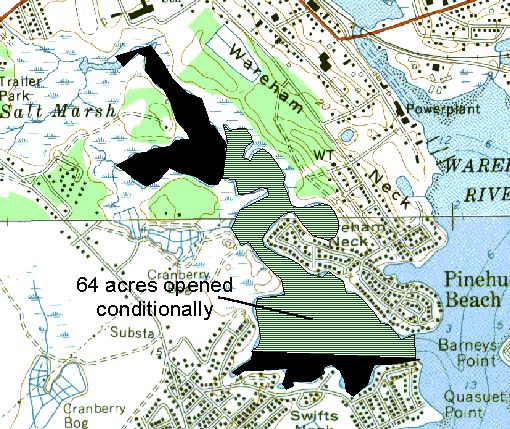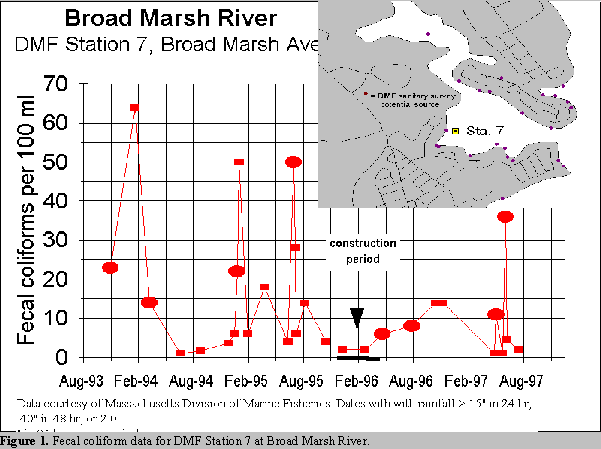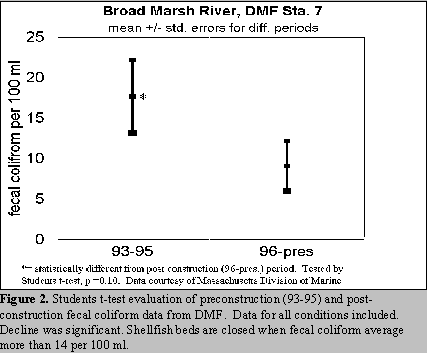The Broad Marsh River Stormwater Remediation Project
An unheralded Buzzards Bay success story:
The Broad Marsh River Stormwater Remediation Project
In 1999, something important happened to a shellfish bed in the Town of Wareham. In public meeting with the Wareham Board of Selectmen, the Massachusetts Division of Marine Fisheries informed the town that a 64-acre area of Broad Marsh River was being reclassified. The meeting, set up to describe the opening date and operating conditions of the site, was broadcast on local cable access TV. Except to some shellfishermen, municipal officials, and residents in the Town of Wareham, the significance of the meeting was perhaps not fully appreciated. The shellfish area, designated as part Shellfish Resource Area BB36, was being changed from “prohibited” to shellfishing to a “conditionally approved.” In plain English, this meant that in an area where it had been formerly illegal to collect shellfish for many years, commercial and recreational shellfishermen could now collect soft-shelled clams and quahogs to eat or sell. The collecting of shellfish was still prohibited during, and for five days after, a moderate rain. However, where shellfish could never be collected, they could now be harvested a good portion of each year.
The reclassification of Broad Marsh River occurred because water quality had improved in this estuary. What is so remarkable about this event, is not that it occurred (although admittedly new shellfish bed closures are unfortunately the more likely trend in many areas), but why it occurred.

The remarkable aspect of the opening was that it was the direct result of the implementation of a stormwater remediation project. Specifically the Town of Wareham Public Works Department constructed and put in place a system to treat stormwater. They were able to do this because of funding from Massachusetts Department of Environmental Protection’s Section 319 Non-Point Source Pollution Program, and technical assistance and guidance by the Buzzards Bay NEP, USDA Natural Resource Conservation Service, and the Massachusetts Department of Marine Fisheries
The whole story
Broad Marsh River, like many small estuaries in southeastern Massachusetts had shellfish bed closures because of elevated fecal coliform levels. And like many other bays and harbors these closures were not the result of a some large outfall pipe, but the result of cumulative impacts from many sources, most of which were conveyed by road stormwater pipes directly to the bay.
The Broad Marsh River Stormwater Remediation Project began in 1991 when the town of Wareham requested funding through the Buzzards Bay NEP’s (BBP) mini-grants program. The Town submitted a proposal to improve the water quality in the lower section of Broad Marsh River through the remediation of stormwater discharges. These discharges showed elevated counts of fecal coliform bacteria during rain storms. The Town, in consultation with the Massachusetts Division of Marine Fisheries (DMF), believed these discharges were a significant contributor to shellfish bed closures in Broad Marsh River. In addition, several public and private beaches are located along the river. While these beaches had not been closed due to fecal coliform bacteria, the Town was concerned about the public health risks associated with the stormwater runoff.
Due to limited finances, the Buzzards Bay NEP was unable to provide the funds for the Broad Marsh River Project in 1991. However, in 1992, the Buzzards Bay NEP, in collaboration with the Town of Wareham, submitted a proposal to the Department of Environmental Protection, Office of Watershed Management (the Department), through the S.319 Nonpoint Source Pollution (NPS) program. In June 1993, the Town was awarded $88,450.00 from the Department to remediate the stormwater discharges. In the proposal, the town committed to an additional $71,020.00 contribution as match (cash and in-kind).
In 1993, the BBP and the Town requested planning and technical assistance from the USDA Natural Resources Conservation Service (NRCS). NRCS put together an interdisciplinary team (including engineers, biologists, soil conservationists, a geologist and a soil scientist) to work with BBP and Town representatives to identify alternatives and select best management practices. Several alternatives to reduce the coliform loads from the stormwater runoff were considered. The sandy soils in the project area made infiltration a practicable alternative. Infiltration practices such as trenches and basins were known to be highly effective in removing fecal coliform bacteria from stormwater runoff. Due to land constraints, subsurface (under-the-road) infiltration structures, were selected as the most economically feasible for the Town to install.
As part of the Memorandum of Understanding with the Town, NRCS provided the site investigations, survey work and designs needed to implement the project. The design of the infiltration structures went through several revisions before being finalized in April 1995. The extended length of time needed for completing the designs were the result of considerably less than expected space for infiltration basins due to the narrowness of the roads and the configuration of the many utilities under the road. This forced a reevaluation of infiltration targets and policies by the Buzzards Bay NEP, NRCS, and the Town.
In October 1995, the Town awarded the construction contract to a local firm (C. C. Construction) which began in November in the Pinehurst Beach section. Installed were two types of infiltration structures, concrete galleys and plastic chambers. The plastic chambers were utilized in areas with high groundwater. Construction of this project was completed in April 1996. To complete the construction of the project, the Town cash contribution alone equaled more than $70,000. With in-kind contributions by the Town, the Town’s total match was estimated to be approximately $85,000.
Prior to the construction of the infiltration structures, the Town distributed a Broad Marsh River Project brochure to homeowners in the immediate area. The brochure, written by the Buzzards Bay Project, described the purpose of the project, what the construction entailed, and what the general public could do to improve water quality. The materials in the brochure were also used to develop an informational sign and a display. The sign was placed onsite during construction. Once the construction was completed, the display, depicting the locations of completed Wareham stormwater remediation projects, was put together by the Town and the Buzzards Bay NEP. The display is currently in the Wareham Public Library and will eventually be placed in the Wareham Town Hall.
Following construction, the Buzzards Bay NEP monitored three infiltration systems starting in October 1996 and ending in June 1997. Parameters such as metals (Zinc, Copper, Cadmium, Chromium, and Lead), Total Suspended Solids (TSS), Total Petroleum Hydrocarbons (TPH), and Volatile Organics (VOC) were monitored in the catch basins and the groundwater wells once during a rain event. Most of these contaminants that had elevated levels in the discharge were reduced greatly by the infiltration.
Fecal coliform bacteria, the pollutant of primary concern, was monitored during five rain events (during the rain or shortly after). Samples were taken at the catch basins (when water was flowing in the basin), the groundwater wells, and the river. The Division of Marine Fisheries, in their efforts to assist the Town of Wareham and the Buzzards Bay NEP, increased their fecal coliform monitoring of the river and also provided verbal observations of the discharges. Overall, the monitoring results from the catch basins and groundwater monitoring wells, indicate that infiltration structures are highly effective in removing fecal coliform bacteria, often exceeding 99.99% reductions.
However, fecal coliform levels in the receiving waters were more difficult to interpret because many other non-point sources of pollution contribute to both background and stormwater related increases. An example of the variability in water quality at one of the stations monitored is shown in Figure 1. Much of the variability shown is due to differences in rainfall volumes, water temperature, and time since the last rainfall. Despite this noise, a statistical analysis of the data by the BBP as shown in Figure 2, demonstrated that post-construction fecal concentrations in the receiving waters were significantly lower than preconstruction conditions.
Based on these data, at the end of 1998 the Massachusetts Division of Marine Fisheries, the agency responsible for opening shellfish beds in Massachusetts, opened 67 acres of the Broad Marsh River estuary to shellfishing for the first time in many years. The new classification for the area means that the shellfish beds remain open except when there is a rainfall of at least 0.5 inches when this bay is closed for five days. This remediation project has now become one of the best examples in Buzzards Bay of how the remediation of the first flush of stormwater discharges can result in the reopening of shellfish beds. It is also a tribute to the hard work of Buzzards Bay municipalities and the Division of Marine Fisheries, working cooperatively, to achieve environmental goals.


Broad Marsh River Stormwater Remediation Project.
This is the final report (as a 700K PDF file) on the Town of Wareham and DEP 319 program funded stormwater remediation project to help open shellfish beds.